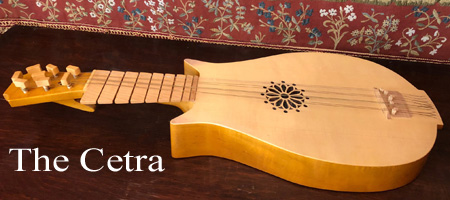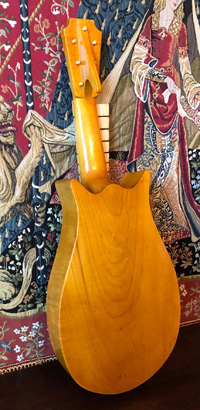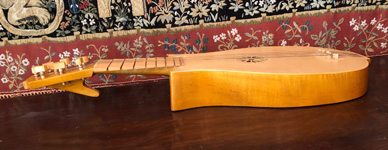

 |
|
 |
Back to Building Historical Musical Instruments |
Building the Medieval CetraThe body, neck and pegbox of the medieval cetra was carved from a solid block of wood. For this cetra I used a block of maple 4 inches thick. The soundboard was glued on separately. Owing to the unreliability of glues during the middle ages, this construction technique would have resulted in an instrument that didn't come apart very often. I built the cetra at right in this style, with a traditional hooked style of neck. This instrument was strung with eight soft iron and twisted brass bass strings and is played with a plectrum. The stepped fingerboard is made of small blocks of wood glued on separately. Each block is wedge shaped, higher at the pegbox end to make a "fret". The very unusual elongations of the frets are still very much a mystery, but I am interested in building instruments as closely as possible to what was used in the Middle Ages or Renaissance, and then discovering what can be done with them. The pegs are boxwood and the soundboard is Picea Abies (German white spruce). The rosette is copied from period iconography. Prior to the exhaustive scholarship of Crawford Young, few people knew or believed that the instrument even existed. By discovering iconography depicting a plucked chordophone with consistent salient features, found exclusively in Italy, including drawings, paintings, sculpture, and even intarsia (wood inlay), he was able to compile a chronological field of data between 1100 and 1530 that confirms the existance of this instrument. All of the depictions show the strangely shaped wooden block frets, a feature that appears on no other instrument. Crawford's monumental 834 page tome La Cetra Cornuta, The Horned Lyre of the Christian World documents the music literature, and icongraphy of the cetra. For many years, the cetra was confused with the cittern. But the unique morphology of this instrument cannot be challenged. The cetra was primarily used by singers to accompany themselves singing Lauda, hymns to Mary, Medieval sequences and devotional monophonic songs. Crawford has also demonstrated convincingly that it can be played as a solo instrument for simple monophonic dances of the 14th century. |
 |
 |
 The Italians probably experimented with different types of metal strings. I used soft iron and twisted brass basses, materials available at that time, in order to produce the most convincing sound. I don't think I need to make too many comments about the following photos; they are pretty much self-explanatory. |
|
|
| About Us | Music Samples | Our Instruments | Instrument Making | Calendar | Contact | Links | Home | Sitemap |